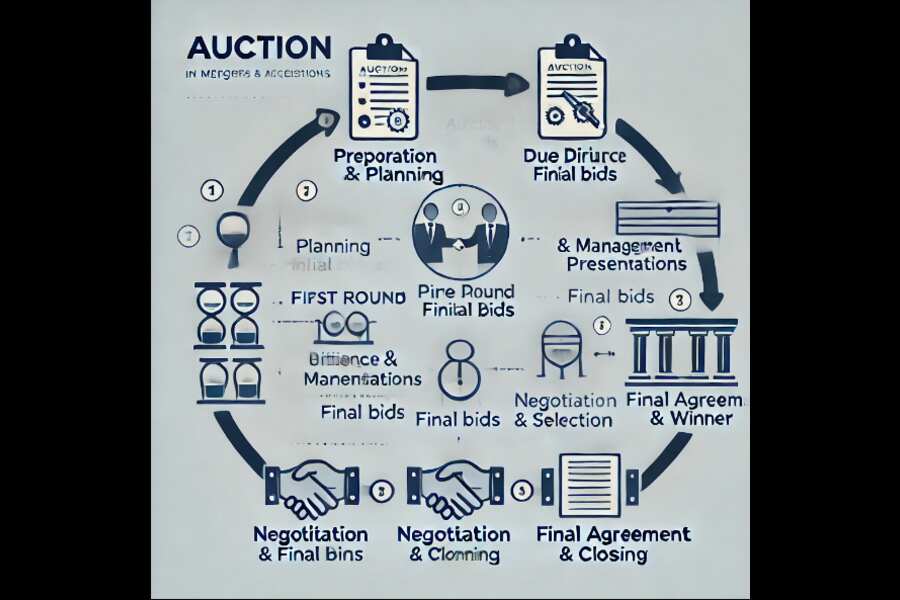The auction process is a structured method of selling a company or its assets, widely used in Mergers and Acquisitions (M&A). This process involves inviting multiple potential buyers to submit competitive bids, with the goal of maximizing the sale price and achieving favorable deal terms for the seller.
Why Use the Auction Process in M&A?
In M&A transactions, the auction process benefits sellers by creating competition among buyers. Unlike a negotiated sale, where a deal is made directly with one buyer, an auction encourages multiple parties to bid, increasing the likelihood of securing the best price and terms. It also helps maintain a level of confidentiality and control over the transaction.
Types of Auction Processes
There are two main types of auction processes in M&A:
- Broad Auction:
- The seller invites a large number of potential buyers to participate.
- It maximizes competition but requires significant time and resources.
- Best suited for businesses with wide market appeal.
- Limited (Targeted) Auction:
- A smaller, carefully selected group of buyers is invited.
- It balances competition with confidentiality.
- Works well for businesses with strategic or niche buyers.
Key Stages of the Auction Process
The auction process typically follows several structured stages:
1. Preparation and Planning
- The seller, with the help of financial advisors, prepares key documents, including:
- Confidential Information Memorandum (CIM): A detailed document about the business’s financials, operations, and market position.
- Teaser: A short, anonymous summary sent to potential buyers to gauge interest.
- Non-Disclosure Agreements (NDAs): Ensuring confidentiality before sharing sensitive data.
2. First Round (Initial Bids)
- Interested buyers receive the CIM and submit non-binding offers based on preliminary analysis.
- The seller reviews these offers and selects a shortlist of buyers for the next phase.
3. Due Diligence & Management Presentations
- Shortlisted buyers conduct in-depth due diligence, reviewing financial records, legal contracts, and operational details.
- They may meet with company management to ask questions and assess strategic fit.
4. Second Round (Final Bids)
- Buyers submit binding final bids, which include detailed valuation, financing structure, and deal conditions.
- The seller evaluates these offers based on price, certainty of closing, and strategic alignment.
5. Negotiation & Selection of Winner
- The seller negotiates terms with the leading bidder, sometimes leveraging other offers to secure the best deal.
- The winning bidder is chosen based on the best combination of price and deal certainty.
6. Final Agreement & Closing
- Both parties sign a definitive agreement, and the deal proceeds to regulatory approvals (if required).
- After fulfilling all conditions, the transaction officially closes.
Challenges and Considerations
While the auction process can maximize value, it also has potential drawbacks:
- Time-Consuming: Requires extensive preparation and multiple negotiation rounds.
- Risk of Confidentiality Leaks: A broad auction may expose sensitive business information to multiple parties.
- Uncertainty: Not all invited buyers may submit serious bids, leading to potential inefficiencies.
Conclusion
The auction process in M&A is a powerful tool for sellers looking to maximize their company’s value. By fostering competition among buyers, it enhances pricing outcomes and improves deal terms. However, careful planning, strategic selection of bidders, and strong confidentiality measures are essential to its success. Understanding these dynamics allows both sellers and buyers to navigate M&A auctions effectively and achieve their strategic objectives.

